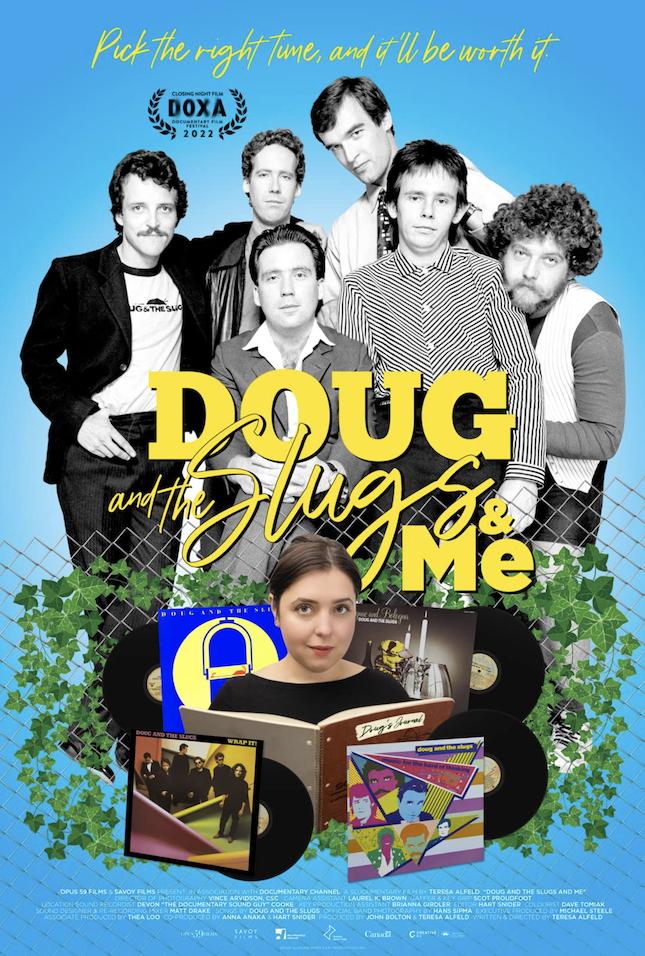Director Teresa Alfeld’s very personal film, “Doug and the Slugs and Me” follow the rise, fall and legacy of the 1980’s band led by singer Doug Bennett, who happened to be her Vancouver neighbour when she was a kid. For years, Bennett’s raspy voice became an iconic staple of Canadian music. The Slugs whose mix of New Wave, R&B, Reggae and Ska nearly broke the band into the U.S. market however remained a uniquely Canadian success story even with an appearance on the Arsenio Hall show. Fans may remember hits including “Too Bad,” “Day By Day,” “Makin’ It Work,” “Chinatown Calculation” and more.
Teresa was practically raised at Shea Bennett’s home in the 1990s who was her best friend and next door neighbour. She was aware that Shea’s father Doug Bennett was the lead singer of Doug & The Slugs, however had no idea how well known they were. When Teresa and Shea’s friendship came to an abrupt end in high school, the former BFF’s completely lost touch with each other. In 2004, Teresa was beyond surprised to hear Doug had passed away at 52.
Throughout the film, Teresa gains impressive access to Bennett’s family. In turn, the director becomes a central figure in her own film and has no issues when the lens magnifies her past. The camera captures her reuniting with Shea and her sisters as the bond they all shared is reignited.
As Teresa becomes more familiar with the band and the Bennett family, she begins to understand that there was more going on next door than she could comprehend as a child. “What was going to be a quick and dirty rock-doc soon blossomed into a four-year journey,” says Teresa in a director’s note on the documentary’s website. “What started as a simple profile of this unique band became very personal, very fast, and despite my reluctance, I had to stop fighting the fact that I needed to become a character and enter the story.”
One of Teresa’s key resources when constructing the film was access to the journals that Doug kept from the band’s outset, neatly handwritten in 39 ring-bound notebooks, covering the 1980’s.
What really makes this film profound is her unique perspective. The director is able to share her feelings of loss and despair regarding her own father’s passing which in many ways makes Shea more comfortable confiding in her. As the old friends rekindle their friendship, Teresa shares the private words that Doug wrote, but never made public. While she reads from the stacks of journals written by Bennett, the daughters and their mother also participate in re-discovering their father in a new light. The journals are filled with stories of hope and heartache that involve the narrator for added drama at times. Posthumously, Doug’s voice is heard loud and clear.
Teresa’s interviews with Doug’s former bandmates, his family and his friends, help her learn how Doug & The Slugs went from cult sensation to national notoriety in the early 1990’s. At the time, the band was spewing out hit singles, gold records and receiving constant media attention. Indeed, they were destined to be the next big band to come out of Canada.
Throughout the picture, Teresa interviews a host of Canadian musicians and other celebrities including Sir Bob Geldof, Bif Naked, Steven Page, Ron Sexsmith, Ed the Sock and Terry David Mulligan. From an outsider’s perspective, they discuss the band’s music, videos and stage show. Perhaps what’s most intriguing however, is that they all agree there were too many obstacles prohibiting the band from achieving that next level of international stardom.
The interviews provide insight and the archival footage of the band performing is fascinating but it’s the use of home movies that makes Doug and the Slugs and Me an engaging film that needs to be seen. The existence of the Bennett family home movies came as a surprise to Teresa. In fact, she had no idea that Nancy Hare (Doug’s widow), “had kept this box of home movies until she told me and gave them to me.”
What’s even more compelling is the daughters had never seen the movies either. “Nancy had the tapes in storage and I think everyone forgot they existed. I spent a lot of time in Nancy’s storage container looking at old materials. The girls had not seen these tapes, ever.” Sharing the footage with them “was really special,” Teressa acknowledges.
Like many other bands, Doug and the Slug’s egos got in the way as the majority of the fans seemed to put Doug on a pedestal. As time passed, arguments ensued over the more pop-music direction the band was taking. By the 1990’s, Doug and his wife had a growing family of young kids in a house on Semlin Drive. Solo albums ensued, new band members were brought in and and alcohol consumption was clearly becoming a major issue with the lead singer. After a gig in Calgary in 2004, Doug passed away.
Near the end of the documentary, Teresa and Doug’s daughter return to Grandview Lanes and screen an old video of Doug bowling there. She remembers it was then that she held a camera for the first time in her life. She revisits the moment, “It was all because of Doug.”

